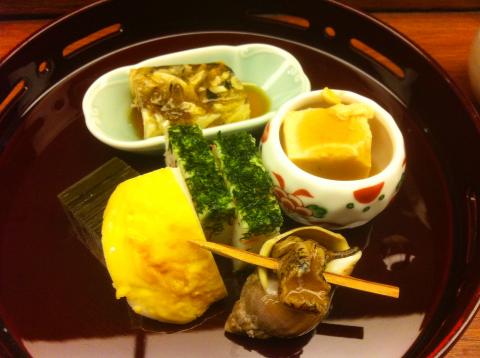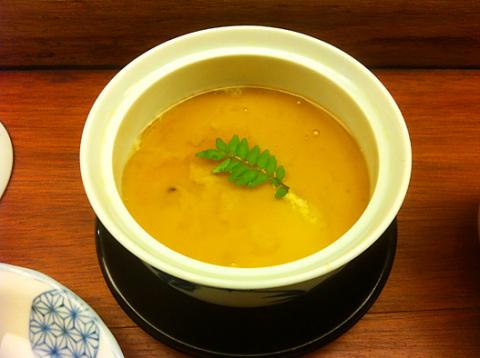Fine Japanese dining is easy to find in Taipei, but Shanhua Cuisine Japonaise (山花) stands a cut above the rest. The restaurant, which sports a facade that looks as if it was plucked straight out of an alleyway in Kyoto, offers simplicity and elegance with a warm, homey touch.
The same might be said of the Japanese-style multi-course meals, or kaiseki, served by restaurateur Lin Kun-tian (林昆田). The 50-year-old Kaohsiung native and life-long chef says he takes a strictly traditionalist approach in preparing meals.
Lin says the key to his meals are fresh ingredients, some locally sourced, most imported from Japan. He stays away from fancy sauces and sticks to simple garnishes, whether it’s a light soy sauce or freshly grated wasabi.

Photo by David Chen
A lunchtime visit left me impressed with Lin’s penchant for the basics. I went for the set of eight “mini-courses” (NT$1,000), which was full of subtle surprises and delights.
The meal started with a cube of sesame tofu topped with a glutinous soy sauce to whet the appetite, and then a platter of sashimi served on a bed of ice in a ceramic cup with a floral design. The petit cucumber with a flower growing out of the end was both a tasty and beautiful garnish.
The tuna and yellowtail slices were as fresh as could be and of high quality, but it was the raw shrimp that bowled me over. The coldness made it sing, and there was a buttery flavor that Lin says comes from a light squeeze of fresh lemon, a flavor I hadn’t noticed. In any case, shrimp will never be the same for me again, at least until my next visit.

Photo by David Chen
The raw delights continued with a serving of calamari (also melt-in-your-mouth delicious), followed by a delicate cut of eel meat served in a light broth.
The next platter offered a bit of exotica: a slice of blowfish skin, which looked like and tasted a bit like jellied ham, and a tofu cube-sized block of monkfish liver, which I enjoyed for its savory, nutty flavor and buttery texture.
The main courses were grilled fish, which had firm but tender white meat similar to grouper, and a soul-satisfying bowl of steamed egg full of stringy mushrooms and chunks of yams. Just in case you aren’t full by this point, the “mini-course” meal ends with a bowl of rice with pickled vegetables and miso soup.

Photo by David Chen
The food and the interior are refined and minimalist, but the vibe is down-to-earth and welcoming. Billie Holliday played in the background as I sat at the solid wood bar in front of a stylish open-air kitchen, where Lin and his team of four chefs multi-tasked with ease. They sliced fish, grated wasabi root and manned the grill, all while engaging in friendly banter with customers, many of whom are middle-aged regulars and business-types.
There is no menu, as diners simply choose how much they want to pay: NT$1,000, NT$1,500 or NT$2,500 for lunch; NT$3,000, NT$4,000 or NT$5,000 for dinner. Higher prices get you more in quantity and quality of ingredients.
Shanhua, which is just a five-minute walk from Liuzhangli MRT Station (六張犁捷運站), is situated in the corner of an old concrete building in a nondescript neighborhood. The restaurant looks out of place with its clean, natural-hued exterior and sliding wooden doors, almost as if it were put there by mistake. Once inside, the food and the atmosphere will indeed transport you to another place.

That US assistance was a model for Taiwan’s spectacular development success was early recognized by policymakers and analysts. In a report to the US Congress for the fiscal year 1962, former President John F. Kennedy noted Taiwan’s “rapid economic growth,” was “producing a substantial net gain in living.” Kennedy had a stake in Taiwan’s achievements and the US’ official development assistance (ODA) in general: In September 1961, his entreaty to make the 1960s a “decade of development,” and an accompanying proposal for dedicated legislation to this end, had been formalized by congressional passage of the Foreign Assistance Act. Two

Despite the intense sunshine, we were hardly breaking a sweat as we cruised along the flat, dedicated bike lane, well protected from the heat by a canopy of trees. The electric assist on the bikes likely made a difference, too. Far removed from the bustle and noise of the Taichung traffic, we admired the serene rural scenery, making our way over rivers, alongside rice paddies and through pear orchards. Our route for the day covered two bike paths that connect in Fengyuan District (豐原) and are best done together. The Hou-Feng Bike Path (后豐鐵馬道) runs southward from Houli District (后里) while the

March 31 to April 6 On May 13, 1950, National Taiwan University Hospital otolaryngologist Su You-peng (蘇友鵬) was summoned to the director’s office. He thought someone had complained about him practicing the violin at night, but when he entered the room, he knew something was terribly wrong. He saw several burly men who appeared to be government secret agents, and three other resident doctors: internist Hsu Chiang (許強), dermatologist Hu Pao-chen (胡寶珍) and ophthalmologist Hu Hsin-lin (胡鑫麟). They were handcuffed, herded onto two jeeps and taken to the Secrecy Bureau (保密局) for questioning. Su was still in his doctor’s robes at

Mirror mirror on the wall, what’s the fairest Disney live-action remake of them all? Wait, mirror. Hold on a second. Maybe choosing from the likes of Alice in Wonderland (2010), Mulan (2020) and The Lion King (2019) isn’t such a good idea. Mirror, on second thought, what’s on Netflix? Even the most devoted fans would have to acknowledge that these have not been the most illustrious illustrations of Disney magic. At their best (Pete’s Dragon? Cinderella?) they breathe life into old classics that could use a little updating. At their worst, well, blue Will Smith. Given the rapacious rate of remakes in modern